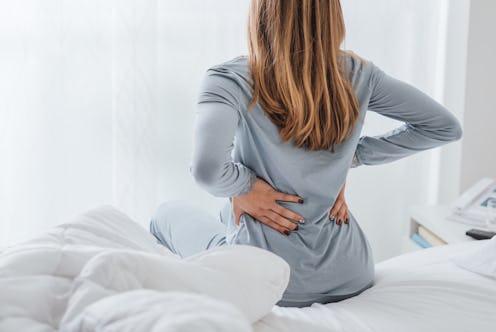Life
5 Unexpected Signs Of Early-Onset Osteoporosis
Most of us don't spend our time worrying about osteoporosis, as it seems like a condition that only affects older women. However, young women can be affected by bone density loss too, which is why it's important to pay attention to the signs of early-onset osteoporosis. Although osteoporosis — which is the thinning of bones where there is a reduction in bone mass — typically occurs in women around 50 years old, it is considered "early-onset" when it occurs before this age.
"Bones are 'alive' constantly, breaking down and building," Navya Mysore MDCM, CCFP tells Bustle. "Bone density is the highest in your twenties to thirties, but starts to decrease slowly after that. Early-onset osteoporosis is when the bone density loss accelerates quicker than expected for multiple reasons."
There are certain individuals who are more at risk for early-onset osteoporosis, according to Myseore. "These include young patients who are extremely athletic but nutritionally deficient, patients with a low BMI or a history of an eating disorder, prednisone use for other medical reasons at a young age, individuals with with Celiac disease, Crohn's disease, thyroid disorders and early-onset menopause or premature ovarian failure. Smoking and heavy alcohol use early on can also put you at risk."
Unfortunately, it's hard to spot osteoporosis early on, as it is usually painless and symptomless until it is too late and an individual has experienced a fracture. However, there are some signs you can look out for that might indicate the beginnings of osteoporosis, especially early-onset. Here are five signs you should be aware of, and consult with your doctor about, according to experts.
1Loss Of Height
One symptom of osteoporosis is shrinking over time. "This is due to the vertebrae thinning out and losing height," says Mysore. This can also occur because of fractures of the bones of the spine or even just from slouching, according to Harvard Health. If you are experiencing any loss in height, you should consult with your doctor to see if it may have anything to do with early-onset osteoporosis.
2Back Pain
Back pain often occurs as part of early-onset osteoporosis, and it is usually caused by a small fracture, says Mysore. According to Everyday Health, you may feel pain in places like your back, but not be able to trace it to a single event. If you suspect that a fracture is possible or you are having pain, especially in this area, see your doctor.
3Stooped Posture
Many people with early-onset osteoporosis begin to have a stooped posture. "This is again caused by vertebrae thinning and compensating for back pain," says Mysore. Something like a curvature in the spine is something to pay attention to, as it can mean that osteoporosis is affecting your vertebrae.
4Receding Gums
One of the more surprising symptoms of early-onset osteoporosis is receding gums. "Your gums can recede if your jaw bone is loosing bone mass," says Mysore. Research has found that dental X-rays are highly effective in distinguishing people with osteoporosis from those with normal bone density, so it is important to see your dentist, especially if you have any of the risk factors for osteoporosis.
5History Of Bone Fractures
If you keep breaking your bones, it's a tell-tale sign that you might have osteoporosis. "These patients have a history of multiple bone fractures that happen easier compared to what would be expected," says Mysore. "Most often patients don't even recall falling or having any trauma, but there is a fracture."
Early-onset osteoporosis can be difficult to spot, but it's important to be aware of the risk factors that make you more likely to suffer from the condition. If you are experiencing any of these symptoms, see a doctor, no matter your age.
